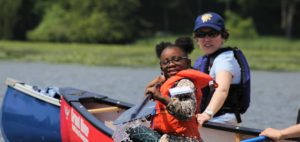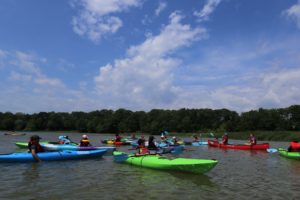Reprinted with permission. Blog originally appeared at Black Outdoors.
 The event was organized by CPAWS Wildlands League, a charity dedicated to protecting the natural environment. The festival introduced city children and youth to nature and the joys of outdoor activities, right in their own backyard. The Rouge River is the eastern boundary of Toronto. It is now protected as part of Rouge National Urban Park, the massive natural wilderness on the city’s doorstep.
The event was organized by CPAWS Wildlands League, a charity dedicated to protecting the natural environment. The festival introduced city children and youth to nature and the joys of outdoor activities, right in their own backyard. The Rouge River is the eastern boundary of Toronto. It is now protected as part of Rouge National Urban Park, the massive natural wilderness on the city’s doorstep.
I was calf deep in warm water as I walked down the road to the canoe launch area. The record-breaking spring floods still covered the concrete in June.
In the car park, two men sat and fished from a bench as the water gently swirled around their knees.
I asked a volunteer paddler to take me out in a canoe. We slipped into the boat and pushed off from the shore. The water splashed softly as the paddles glided through the lily beds. Ahead, the exit from the small inlet was chock-a-block with novice paddlers aiming to get to the main channel. It did not matter that they zig-zagged about or bumped into each other as they tried to steer the canoes and kayaks. What mattered was the grins on their faces.
Out in the main channel we headed up river. Houses peeked out on the left bank, many with their own private decks, and with comfortable chairs expertly posed for sipping wine while enjoying the views of the water. It looked like a scene from cottage country, not something found in the edge of the city with a highway buzzing close by.
 A group of youths in kayaks were way ahead of us. Their strokes were even, graceful and powerful. I did not want to catch up or race these experienced river rats, I simply wanted just to enjoy the bends in the water. I had to pinch myself and remember that I was still in the city. It felt more like I was canoeing deep in the backcountry. I had no idea that the Rouge River was so wide, wild and beautiful.
A group of youths in kayaks were way ahead of us. Their strokes were even, graceful and powerful. I did not want to catch up or race these experienced river rats, I simply wanted just to enjoy the bends in the water. I had to pinch myself and remember that I was still in the city. It felt more like I was canoeing deep in the backcountry. I had no idea that the Rouge River was so wide, wild and beautiful.
A common tern fluttered in front of us. The graceful little white-gray bird had enormous wings compared to its small body. The bird ignored us as it hunted fish for its lunch. We spotted a great blue heron as it landed in the reeds. The landing was more like a belly flop than elegant aerial ballet. Then we paddled over to the right bank of the river, up a secluded channel and away from the crowds. A slight movement in the woods caught my eye. It was a deer perched high on a skinny ledge and watching us. It was a perfect photograph of nature’s majesty. Before I could grab my camera the deer melted away into the forest. The memory of it is etched in my mind. It was fascinating how such a large animal moved so quietly in the woods.
I could easily spend an entire day messing about in a boat on the Rouge River. That day I had only a lunch hour. Earlier I had spotted Kathleen Wynne, the Ontario Prime Minister posing for photographs as she paddled a canoe. The year before it was Justin Trudeau, the Prime Minister of Canada. I remembered that at the time, I thought it was just a carefully edited publicity stunt, as I could not imagine a natural river so close to the city. The city rivers that that I knew are mere shadows, as they are dammed, buried or channeled along the way to prevent flooding.
As we drifted back to the dock, we caught up with a South Asian family in a canoe. They camped and canoed frequently in Algonquin Park. It was their first time on the Rouge River. They lived just ten minutes away and it was by chance that they saw the flyer for the festival. They had their own canoe and were now planning to spend nearly every weekend on the Rouge River. The woman said she wanted the two children to be expert paddlers.
A gaggle of Filipino, white and East Asian children were lined up on the deck waiting for their turn in the boats. Their parents hovered about snapping tons of photographs. Over a hundred canoes and kayaks were already in river, scattered in all directions, with children discovering the joy of water and nature.
Back on shore I chatted to a Black woman waiting for her daughter to return from canoeing. She had seen the flyer at a bus stop near her. She had also seen it in the school and community centre. Finally she called the number and was pleased when a friendly voice encouraged her to give it a try. Her daughter loved canoeing. It was their third year of coming to Paddle the Rouge.
A photographer asked us to pose by the boats as he was surprised to see a Black woman and a Chinese man in a canoe. I chatted to the photographer – a Black youth from a community newspaper. He too was amazed at the number of people of colour at the event. He had expected to feel uncomfortable. He assumed that he would be the only Black face in the vast white space called the Canadian outdoors.
At the end of my shift I returned to the river. Another volunteer took me out in a canoe. She was Latina and used to paddle back home. She did not canoe much in Canada as she could not find a comfortable community to do it with.
Paddle the Rouge turned out to be delightful in so many unexpected ways – from the abundant birds and wildlife to the happy children boating on the river. CPAWS Wildlands League had diversified the outdoors, giving admission to those who traditionally lacked access. If they could do it, what is stopping other outdoors, conservation and environmental groups from doing the same? Black History Walks Toronto.

